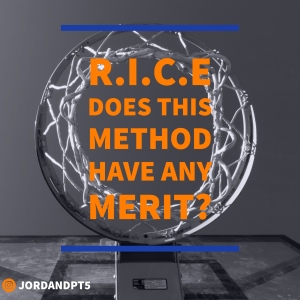Everyone knows the age old technique of handling acute injuries, RICE (Rest, Ice, Compression, Elevation). As more and more research is performed, is this method still the preferred way to handle these acute injuries?
RICE was developed by Gabe Mirkin in 1978 in his book The Sports Medicine Book. But in 2014 after reviewing the latest research, Mr. Mirkin changed his statement and even stated, “Icing does not increase healing, it delays it.” Now Mr. Mirkin recommends avoiding ice all together unless pain is unbearable. The use of ice to help control pain is still a preferred method because many pain medications (Advil, Motrin, Aleve) have an anti-inflammtory properties and these properties interrupt the overall healing process. If medication is necessary, make sure those medications have no anti-inflammtory properties (Tylenol),
As time has passed, more and more research has illustrated the importance of active recovery to aid in improving outcomes following acute injuries. As long as there are no open wounds, fractures, or tendon ruptures starting small movements within an individuals available range of motion is beneficial in aiding the healing process. Once pain is controlled, progressing movement and initiating some weight bearing activities will continue to help advance the tissue along the healing process.
There are 2 new acronyms that are gaining more traction with how to handle acute injuries especially any type of sprain or strain. These acronyms are MEAT (movement, exercises, analgesic, treatment) and POLICE (protect optimal loading, ice, compression, elevation).
MEAT
Movement and exercise can stimulate blood flow, reduce the formation of scar tissue, and improve overall recovery. Analgesics can be used to help control acute pain, BUT make sure not anti-inflammatory properties are in the pain medication. Anti-inflammatory medication can hinder the natural healing process, leading to an extended recovery time. Finally treatment, especially under the guidance of a skilled rehab specialist like a physical therapist, can help improve recovery by providing guidance for appropriate movement/exercise and performing other treatments such as joint mobilizations to minimize the effects of possible immobilization.
POLICE
Protection may be a necessary component during an acute injury to minimize the potential for further tissue damage. Even though the use of splints and/or other devices to minimize weight bearing may be necessary at times, these parameters should only be followed for the first 48 hours. If protection is warranted, the key point to recovery is ACTIVE REST or optimal movement. Muscle loses 3 to 5 percent of its strength daily with complete rest. Therefore, optimal loading should be utilized early on as well as supervised under the direction of a skilled rehab specialist like a physical therapist. Ice can still be effective by providing short term pain relief especially if someone has poor tolerance to pain medication but responds well to NSAIDs (non-steroidal anti-inflammatory drugs). Remember, we want to avoid anti-inflammatories because it can impact the overall healing process. Compression and elevation can control swelling, which in turn can improve the overall healing process. The more swelling is allowed to develop, especially in the lower leg, it can slow recovery secondary to increased limitation in movement of a joint. Inability to actively move a joint through a range of motion, even small, will prolong the overall recovery process from an acute injury.
All in all the concepts behind treatment for an acute injury have moved away from a passive to more active approach and there is plenty of evidence to support this change. Now someone may still require the use of rest and ice but complete immobilization or rest should not be a part of the recovery process especially if the affected area is stable (no fractures, tendon ruptures, open wounds). The assistance of the rehab specialist or health care provider should be highly considered for recovery. The guidance from these professionals can help improve the recovery process and decrease time away from the court/field/track/diamond/pitch.
References:
Doldron, M. (2016, Jan. 4). “MEAT” versus “RICE” in Acute Injury Treatment. Retrieved from: http://www.rebalancetoronto.com/meat-versus-rice-in-acute-injury-treatment/
Michel PJ, Peter AA, Blankevoort L, et al. What is the Evidence for Rest, Ice Compression, and Elevation Therapy in the Treatment of Ankle Sprains in Adults? J Athl Train. 2012; 47(4):435-443.
Mirkin, G. (2016, Oct. 13). Why Ice Delays Recovery. Retrieved from: http://www.drmirkin.com/fitness/why-ice-delays-recovery.html
